In the last lesson we discussed the ecology of the emergent grass community the salt marsh. This lesson we go beneath the waves to the submerged community of the seagrass meadow. But, like the salt marsh, these are not big waves because high energy areas are not what seagrasses like. Large waves can literally rip them out of the ground.
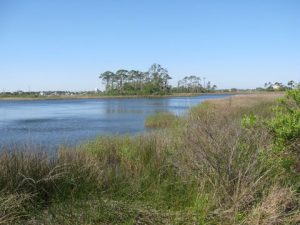
Photo: Rick O’Connor
That said, in Florida Bay and the Florida Keys you do find seagrasses in areas open to the ocean. How can that be? The answer… depth… these grass meadows are growing at water depths of up to 30 feet. This is deep enough to avoid the circulation of the surface waves and this can only happen because the water clarity is good enough that sufficient sunlight can reach them at that depth. You see seagrass, like all plants, needs sunlight and sunlight can be a limiting factor for some life forms underwater. The amount of light needed is at least 25% of the ambient surface sunlight to reach the bottom. This is true in the northern Gulf away from the coral reefs as well. But we mentioned that much of the sediment that would otherwise cloud the water, is trapped by the salt marshes (and other shoreline vegetation) increasing water clarity and creating an environment where seagrasses can thrive. Oysters, and other filter feeding bivalves, are also community members who help increase water clarity. So, you see how the different ecological communities interact with each other so that an entire estuarine ecosystem can function. Remove one piece from the puzzle and changes begin to happen everywhere.
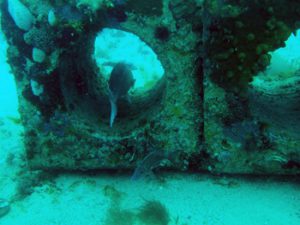
Photo: Bill Lindberg Florida Sea Grant
We now know that two important abiotic environmental factors for the success of a seagrass meadow – low wave energy and high water clarity – what about salinity? Well, like other marine creatures, each species has their salinity tolerance range. We will first indicate that seagrasses are in fact grasses – not “seaweeds”. Seaweeds are nonvascular algae and are abundant in aquatics systems, but they are nonvascular – lacking the true roots, stems, and leaves of vascular plants (read Youth Science Lesson – Life Forms – Lesson 2 Algae and Plants). Seagrass are vascular. What we view about the sediment are the grass blades (leaves). The stems run horizontal underground and are called rhizomes. The roots extend downward from the rhizomes. This is much like the grasses in your yard. And, like the grasses in your yard, they produce flowers. It is not clear how pollination of submerged seagrasses works. Some believe this is done by tiny marine pollinators, like small shrimps, others believe is may be a more self pollinating using flowing water to disperse pollen much the way pine trees use the wind.
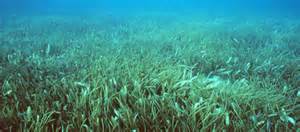
Photo: Virginia Sea Grant
All of this to say that the diversity of vascular grasses that can live underwater (seagrasses) is very small, seven species are known throughout the entire state of Florida, and only about 70 worldwide. Within the seven Florida species three are common in the northern Gulf – turtle grass (Thalassia testudinum), shoal grass (Halodule wrightii), and Widgeon grass (Ruppia maritima). There are records of manatee grass (Syringodium filiforme) in the northern Gulf but it is not as common. Each of these species of seagrass have different salinity tolerances. Turtle, shoal, and manatee grass like the higher salinities of the lower estuary – 20‰ and higher. These are usually found in the protected lagoons and sabines near the mouth of the bay. Widgeon grass can tolerate salinities as low as 10‰ and are more common near the head of the bay where the rivers discharge. There are actually freshwater species of “seagrass” such as tape grass (Vallisneria) which live at 0‰. So, salinity does play a role in the species composition of a seagrass meadow.
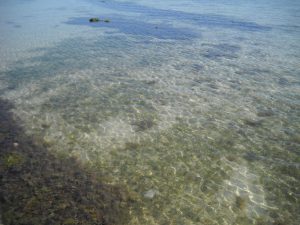
Photo: Leroy Creswell
Another key environmental component interacting with these grasses are the sediments. Like most of the sediments found along our coastal zones, it is dominated by quartz and has little nutrients. However, with the low energy environment, leaf litter and other organics can accumulate and increase the organic content of the sediment. Key organic nutrients needed by these grasses can also be obtained from the water column itself. But, as in all ecological systems, the release of inorganic and organic compounds by the grass themselves helps improve the nutrient content. The presence of grass attracts animals who, in turn, play a role in increasing needed nutrients with their waste. These then feed on the plants, who alter the sediments and feed larger animals, who give off waste and eventually die returning nutrients back the sediments to be used by the plants – and so it goes.
As in salt marshes, you typically find strong zonation of seagrass species in the meadow. Shoal grass is flat and very thin, like human hair, and can tolerate the waves better than turtle grass. Thus, it is found closer to the shoreline where the waves are a little stronger. As you move into deeper water the shoal grass yields to the wider flat blades of the turtle grass. Interestingly, you sometimes find patches of shoal grass further offshore. But when you look closer you will notice that the seafloor has risen to a height where the grass is exposed to the surface waves once again, and the turtle grass yields to the shoal grass. Shoal is another term for shallow and probably where it got its common name from.
The grazers…
The first community of animals you expect are those that feed on the grasses. But, as in salt marshes, most of the seagrass meadow grazers do not feed on the grasses themselves. Some do – green sea turtles feed on “turtle grass” and manatees feed on “manatee grass”. If the salinity is high enough you might find sea urchins grazing on seagrass. But most feed on the leaf litter of the dead blades, or on the epiphytes, and epizoids that grow on the grass blades. Epiphytes are plants that grow attached to plants. Epizoids are animals who do the same. These are tiny creatures who feel like “scum” on the grass blades themselves. Small microscopic shrimp-like creatures called amphipods can be found grazing on these. Detritivores can be found scrapping this from the blades or meandering through the meadow feeding on the leaf litter. Polychaete worms, mollusk, and small crabs can be found everywhere. There are numerous filter feeders such as tubeworms, clams, and the famous bay scallop, “grazing” phyto and zooplankton from the water column itself – helping to maintain the needed water clarity for the seagrass to grow. Penaid shrimp (pink, brown, and white) are found here feeding on detritus and will eventually grow into adults and support one of the largest commercial fisheries in the Gulf of Mexico.

Photo: University of Florida
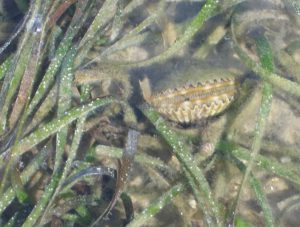
Photo: FWC
Some of the more unique grazers include the pipefish and seahorses. These small armored fish mimic the seagrass so well they really cannot live anywhere else. They hang in the meadow using their vacuum-like snout to suck in the small amphipods and crustaceans grazing on the detritus and epiphytes.

Photo: University of Florida.
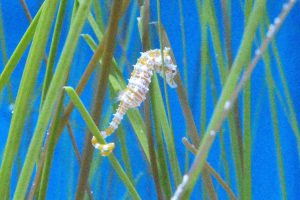
These tiny grazers are prey for mid-sized predators like pinfish, pigfish, and blennies. Conchs, whelks, and horseshoe crabs are some of the invertebrate predators found here.

Photo: Nicholls State University

Photo: UF IFAS Franklin County Extension
The larger predators would include creatures like octopus, gray snapper, toadfish, and speckled seatrout. Stingrays, jacks, barracuda, and even some species of shark visit seagrasses in search of food. Some predators do not live in the grass itself but prefer to hang along the sandy margins of the beds waiting for someone to make a mistake and try swimming from one clump of grass to another.

Photo: University of Southern Mississippi

Photo: Florida Museum of Natural History.
As with salt marshes, seagrass meadows are an excellent nursery ground for many species. There is plenty of food and hiding places for the developing young who, also need the lower salinities of the estuary in the early stages of their lives before they move offshore.
And, as in all ecosystems, these different creatures completely interact with each other. They create, and react, to change in the sediment, nutrients, depth, and population control of each community member.
ACTIVITIES
- To truly explore the seagrass community – you need to visit one and spend some time there. Snorkeling is a great way to explore local seagrass beds. Mask come in all shapes and sizes. We recommend purchasing one with a double seal. Place the mask on your face and suck in with your nose. The mask should stick to you face tightly for a few seconds. If it does not, find another with a different shape to it. This will help prevent leaking while snorkeling. There are different methods, and products, to help reduce “fogging” of the mask. We recommend using one of these. We do not recommend fins unless the water is deep. Fins will stir up all of the leaf litter detritus and muck accumulated by the grasses and make visibility difficult. If in deeper water, not only fins but a belt with about 2-3 pounds of weight will help. Snorkels come in all shapes and sizes and you can practice clearing you snorkel in shallow water before heading into deeper water. We also recommend gloves. You must display a dive flag, and stay within 100’ of it, if snorkeling in Florida waters. Have fun… you are going to see a lot of cool things.
- Seine netting is another way to see the creatures who live in the grass bed community. These are small nets attached to poles that resemble volleyball nets. It takes two people to do this. Both of you will walk into knee deep water within the grass. You will extend the net and place the poles on the bottom, weights down, floats up. Keeping the poles on the bottom at all times, you can make a sweep through the grass before bringing the net to the beach. Here you can pinch the top and bottom of the net together and set it right at the edge of the water to observe a variety of cool creatures. Be careful of blue crabs and pinfish which can pinch and poke. Keep the animals wet so they can breath and do not hold them out of the water for too long. You should find a lot of creatures this way.
- Few people know about the epiphytes and epizoids that grow on the grass. They look and feel like “scum”. You can take your thumb and rub it down a grass blade to feel them. With a bucket and small hand lens, you MIGHT be able to seem them closer up.
 0
0
